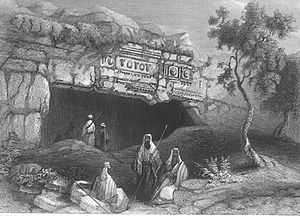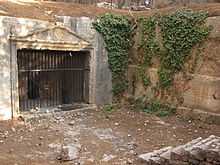Rock-cut tombs in ancient Israel
Hundreds of rock-cut tombs were constructed in Israel in ancient times. They were cut into the rock, sometimes with elaborate facades and multiple burial chambers. Some are free-standing, but most are caves. Each tomb typically belonged to a single, wealthy family. Bodies were laid out on stone benches. After a generation, the bones were moved to a bone chamber or, later, into ossuaries and the benches used for new burials. Rock tombs were the province of the wealthy; the common people were buried in the ground.
The tombs date from several periods. The earliest Canaanite cut-rock cave tombs date from 3100–2900 BCE, but the custom had lapsed a millennium before the earliest Israelite tombs, which date to the 9th century BCE in Jerusalem. There are a great many Jewish tombs dating to the Second Temple period, and others in the late Roman or early Byzantine period.
Canaanite period
Early Canaanite I (3100-2900 BCE) period tombs are the earliest rock-cut tombs yet discovered in Israel; several have been found beneath the Ophel in Jerusalem. The custom had lapsed by the second millennium.[1]
Biblical tombs

A number of rock-cut tombs are mentioned in the Bible. The first was purchased by Abraham for Sarah from Ephron the Hittite (Gen. 23:20). Traditionally, this tomb, which may have been either a rock-cut or a natural cave, is identified with the Cave of the Patriarchs (also called the Cave of Machpelah). According to very old traditions, Abraham, Rebekah and Isaac, Jacob and Leah were also buried there (Gen. 25:9; 49:29-32). In Acts 7:16, it is said that "Their (Jacob and his family) bodies were brought back to Shechem and placed in the tomb that Abraham had bought from the sons of Hamor at Shechem for a certain sum of money." Mentions of rock-cut tombs are also found in the Judges 8:32; 2 Samuel 2:32; Second Kings 9:28; 23:30; 21:26; 23:16; Matthew 27:60).
First Temple period
The [Silwan necropolis], the most important ancient cemetery of the First Temple period, is assumed to have been used by the highest-ranking officials residing in Jerusalem, the capital city of the Kingdom of Judah. Its tombs were cut between the 9th and 7th centuries BCE.[2] It is situated on the rocky eastern slope of the Kidron Valley, facing the oldest part of Jerusalem. The Arab village of Silwan was later built atop the necropolis.[3][4] Although the existence of ancient tombs in the village of Silwan had been known since the 19th century, the first careful survey was not performed until 1968. Charles Warren, who was thwarted in his efforts to carry out a full survey of the tombs, in some of which villagers were living, attributed this to "the hostile nature of the villagers" whom he described as "a lawless set."[2][5] All of the tombs were long since emptied and their contents removed.[3] A great deal of destruction was done to the tombs over the centuries by quarrying and by their conversion for use as housing, both by monks in the Byzantine period, when they were used as monks' cells and some even as churches, and later by Muslim villagers "[w]hen the Arab village was built; tombs were destroyed, incorporated in houses or turned into water cisterns and sewage dumps."[2]
The necropolis is an archaeological site of major significance. In the 19th century it contained some forty rock-cut tombs of distinguished caliber, of which most were still preserved by the late 1960s.[3] The inscriptions found on three of the tombs are in Hebrew.[3]
The architecture of the tombs and the manner of burial is different "from anything known from contemporary Palestine. Elements such as entrances located high above the surface, gabled ceilings, straight ceilings with a cornice, trough-shaped resting-places with pillows, above-ground tombs, and inscriptions engraved on the facade appear only here."[2] The stone benches on which bodies were laid out and the small square entrance doors are similar to those found elsewhere in Judah. Ussishkin believes that the architectural similarity to building styles of the Phoenician cities validates the Biblical description of Phoenician influence on the Israelite kingdoms.[2]
If the ancient Israelite kingdoms followed the practice of other west-Semitic kingdoms, the kings themselves would have been buried within the city walls, underneath the royal palace.[1] The scholarly consensus is that the royal palace stood on the opposite hill to the west.
Types of tombs at Silwan necropolis
There are three different types of tombs in the Silwan necropolis, each type concentrated in one specific area.
Seven of the tombs feature gabled ceilings and extremely fine stonework. David Ussishkin describes them as "among the most beautifully rock-cut tombs known in the Jerusalem area even when compared with tombs of later periods."[2] In contrast with the extensive family tombs of later periods, these are for single or double burials, with only one of the seven having room for three bodies. Later destruction has effaced the original doorways.[2]
A second tomb type described by Ussishkin has flat ceilings and 1, 2 or 3 chambers of well-dressed stone carefully squared into spacious rooms. One features a rear chamber of especially "impressive" scale and quality.
There are tombs combining characteristics of the two described here above.
The third type consists of just three "magnificent" monolith tombs, now located in the northern part of the village. These have been carved out of the cliff to create free-standing buildings above the underground burial chambers. Hebrew inscriptions survive on these three tombs; these are the only ancient inscriptions that survive in Silwan.[2]
The following are the three monolith tombs:
Tomb of Pharaoh's Daughter
The most famous of the ancient rock-cut tombs in Silwan is the finely carved monolith known as the Tomb of Pharaoh's Daughter.[3] It is the only one of the three free-standing tombs in which the above-ground chamber survives, although the pyramid-shaped roof is missing because it was quarried for stone. The ceiling is gabled.[2]
Tomb of the Royal Steward

Another notable tomb, called the Tomb of the Royal Steward, is now incorporated into a modern-period house in the main street of the village. At one point plastered for use as a cistern, in 1968 it was in use as a storage room.[2][3] It was discovered in 1874 by Charles Simon Clermont-Ganneau.[2]
The ancient inscription reads "This is the tomb of [...]yahu who is over the house. No silver or gold is here but (his bones) and the bones of his Amma. Cursed be the man who opens this."[1] The first part of the Hebrew name is effaced, but it refers to a Judean royal steward or chamberlain.[1][3] Clermont-Ganneau shipped the tomb inscription to the British Museum, but it was only deciphered in the 1950s by Nahman Avigad.[3][6] Some scholars believe that this is the tomb of the biblical Shebna, the steward and treasurer of King Hezekiah (727-698 BC). It is thought that at the relevant time the same name could be written with or without the ending -yahu, thus allowing Shebanyahu as a variation of Shebna. According to David Ussishkin, the tomb contained two chambers, the outer chamber with a probable double bench for the occupant and his wife, and an inner chamber with a single burial bench for a relative who may be referred to in the second inscription fragment.[7] The Book of Isaiah (22:16) reproaches Shebna for his presumption: "What hast thou here and whom hast thou here, that thou hast hewn thee out a sepulchre here, as he that heweth him out a sepulchre on high, and that graveth an inhabitation for himself in the rock?"[1]
... burial of Z ...
Another former monolith was first described in 1968 by Ussishkin. At that time it was located under the courtyard of a modern-period house serving as a cistern.[2] It has "the finest and most delicate stone dressing in the Silwan necropolis."[2] The upper story was destroyed for use as quarried stone in the Roman/Byzantine period. Only a small section of the inscription survived to be recorded by Ussishkin. The first line is "[This is the] burial of Z ...". The second line "(the one) who op[ens] (this tomb) . .." The third line was illegible.[2]
Second Temple period
During the Second Temple period, rock-cut tombs were built outside the walls of the city of Jerusalem in every direction.[8] The tombs extend as far as 7 km from the city walls, with the more prestigious tombs located close to the city.[8]
Among the notable tombs are the Jason's Tomb, a large, elaborate, family tomb with multiple chambers and inscriptions in both Hebrew and Greek.[8] The most elaborate group of tombs, and apparently the most prestigious location, was in the Kidron Valley beneath the tombs of the ancient Kings of Judah on the ridge where the village of Silwan now stands. These include the Tomb of Benei Hezir, the Tomb of Zechariah and the Tombs of the Kings which, ironically, is the tomb not of kings, but of a queen, Queen Helena of Adiabene.[8]
The elaborate Tombs of the Sanhedrin lie to the north of the city.[8] They were so called by later generations because the largest of them contains 70 chambers with burial benches, and the Sanhedrin had seventy members.[8] Each of the three tombs would actually have contained the burials of a single, multi-generational, wealthy family. They were constructed between the reign of Herod and the year 70.[8]
Tomb of Jesus
According to the Gospels, Jesus was laid out in a rock-cut tomb owned by Joseph of Arimathea.[9] Proposed candidates for the tomb include the rock-cut chamber underneath the Church of the Holy Sepulchre, the Talpiot Tomb, and the Garden Tomb.
Beit She'arim

Beit She'arim National Park in the Galilee preserves a large number of rock-cut Jewish tombs from the 2nd to 4th centuries CE.[10]
References
| Wikimedia Commons has media related to Rock-cut tombs. |
- ↑ 1.0 1.1 1.2 1.3 1.4 "Ancient Jerusalem's Funerary Customs and Tombs: Part Two, L. Y. Rahmani, The Biblical Archaeologist, Vol. 44, No. 4 (Autumn, 1981), pp. 229-235.
- ↑ 2.0 2.1 2.2 2.3 2.4 2.5 2.6 2.7 2.8 2.9 2.10 2.11 2.12 2.13 The Necropolis from the Time of the Kingdom of Judah at Silwan, Jerusalem, David Ussishkin, The Biblical Archaeologist, Vol. 33, No. 2 (May, 1970), pp. 33-46
- ↑ 3.0 3.1 3.2 3.3 3.4 3.5 3.6 3.7 Ussishkin, David. "Silwan, Jerusalem: The Survey of the Iron Age Necropolis". Tel Aviv University.
- ↑ Bible Encyclopedia entry: Siloam International Standard Bible Encyclopedia.
- ↑ Charles Warren, Underground Jerusalem, (1876), p. 149.
- ↑ Nahman Avigad, Israel Exploration Journal, III (1953), 137-52; V (1955), 163-66.
- ↑ "On the Shorter Inscription from the "Tomb of the Royal Steward," David Ussishkin, Bulletin of the American Schools of Oriental Research, No. 196 (Dec., 1969), pp. 16-22,
- ↑ 8.0 8.1 8.2 8.3 8.4 8.5 8.6 "Ancient Jerusalem's Funerary Customs and Tombs: Part Three Ancient Jerusalem's Funerary Customs and Tombs: Part Three, L. Y. Rahmani, The Biblical Archaeologist, Vol. 45, No. 1 (Winter, 1982), pp. 43-53,
- ↑ "Mark 15:46". Bible.cc. Retrieved 2013-04-25.
- ↑ The Oxford encyclopedia of Archaeology in the Near East, Volume 1, p. 309-11.
| ||||||||||||||||||||||
